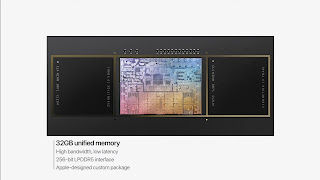M1 Pro and M1 Max combine the CPU, GPU, I/O and Neural Engine in a single System on a Chip(SoC) with Unified memory. CPUs in M1 Pro and M1 Max are the same 10-core CPU, and deliver up to 70 percent faster CPU performance than M1. The GPU in M1 Pro(16-core GPU) is up to 2x faster than M1 while the one in M1 Max(32-core GPU) is up to 4x faster than M1. Both chips feature the same 16-core Neural Engine. The M1 Pro has up to 32 GB of unified memory, while the M1 Max goes up to 64GB. What separates the M1 Max from the M1 Pro isn’t CPU cores but it’s the GPU cores and memory bandwidth, media encoding and decoding, and total overall memory.
Image credit: Apple
M1, the chip that started it all
Image credit: Apple
Apple on October 18, 2021 announced M1 Pro and M1 Max, the next breakthrough chips for the Mac. Apple M1 Chip is the same underlying technology of the two new chips and November 11, 2020 launch of M1 was hailed as an amazing, revolutionary move. The Apple M1 is an ARM-based system on a chip (SoC). It was designed by Apple Inc. as a central processing unit (CPU) and graphics processing unit (GPU) for its Macintosh computers and iPad Pro tablets. It was mostly an evolution of the A12X and A12Z chips that powered the iPad Pro. The M1 has 4 high-performance and 4 energy-efficient cores. It integrates an Apple designed 8-core graphics processing unit (GPU).
While the M1 chip was a great start, serving the needs of Apple’s professional user base would be a tougher trick to pull off. Keeping this in mind, Apple unveiled their new generation MacBook Pro laptop series(2021), a new range of flagship devices that bring with them significant updates to the company’s professional and power-user oriented user-base. Scaling up M1’s transformational architecture, M1 Pro offers amazing performance with industry-leading power efficiency, while M1 Max takes these capabilities to new heights. Apple's chips are built by Taiwan Semiconductor Manufacturing Company (TSMC), a company that builds all of Apple's A-series and M-series chips. Read below to understand these new SoCs in more detail.
Apple's M1 PRO
Image credit: Apple
The M1 PRO, along with the M1 MAX, is Apple's second System on a Chip (SoC) developed for use in Macs. Utilising the 5-nanometer process technology, M1 Pro packs in 33.7 billion transistors, which is more than 2x the amount in M1. As a "System on a Chip," the M1 Pro integrates several different components, including the CPU, GPU, unified memory architecture (RAM), Neural Engine, Secure Enclave, SSD controller, image signal processor, encode/decode engines, Thunderbolt controller with USB 4 support, and more, all of which power the different features in the Mac.
CPU
Image credit: Apple
A new 10-core CPU(8 high-performance cores and 2 high-efficiency cores) is up to 70% faster than M1. According to Apple, "Even the most demanding tasks, like high-resolution photo editing, are handled with ease by M1 Pro." Compared with the latest 8-core PC laptop chip, M1 Pro delivers up to 1.7x more CPU performance at the same power level and achieves the PC chip’s peak performance using up to 70 percent less power.
GPU
Image credit: Apple
M1 Pro has an up-to-16-core GPU. It is up to 2x faster than M1 and up to 7x faster than the integrated graphics on the latest 8-core PC laptop chip.
Media Engine
Image credit: Apple
M1 Pro includes an Apple-designed media engine that accelerates video processing while maximising battery life. M1 Pro also includes dedicated acceleration for the ProRes professional video codec, allowing playback of multiple streams of high-quality 4K and 8K ProRes video while using very little power.
Memory and Other Features
Image credit: Apple
M1 Pro offers up to 200GB/s of memory bandwidth with support for up to 32GB of unified memory. M1 Pro's CPU and GPU share a single pool of unified memory. That means every part of the chip connects to data and memory without needing to copy it, so everything you do is faster and more efficient.
Image credit: Apple
This SoC has a dedicated 16-core Neural Engine for machine learning.
Image credit: Apple
Apart from these, there are several other built-in technologies like a Display engine that drives external displays, a custom image signal processor used to enhance the camera's image quality, Integrated Thunderbolt 4 controllers that offer more I/O bandwidth than before and Secure Enclave with hardware-verified secure boot and runtime anti-exploitation technology.
Apple's M1 MAX
Image credit: Apple
Apple claims it to be "The World’s Most Powerful Chip for a Pro Notebook". The M1 MAX is essentially identical to the M1 Pro in terms of architecture and in many of its functional blocks, but what sets the Max apart is that Apple has equipped it with much larger GPU and media encode/decode complexes. With 57 billion transistors — 70 percent more than M1 Pro and 3.5x more than M1 — M1 Max is the largest chip Apple has ever built.
As a "System on a Chip," the M1 Max also integrates several different components, including the CPU, GPU, unified memory architecture (RAM), Neural Engine, Secure Enclave, Thunderbolt controller with USB 4 support, and more. Overall, Apple has doubled the number of GPU cores and media blocks compared to M1 Pro, giving the M1 Max virtually twice the GPU and media performance.
CPU















